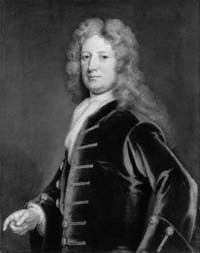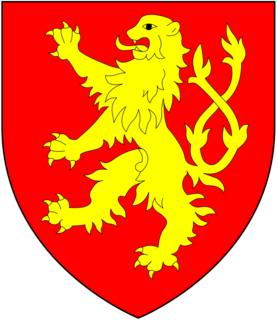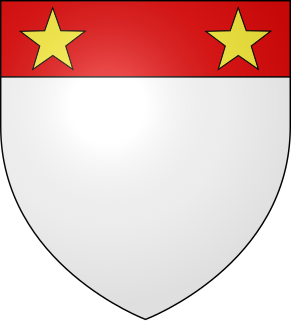Related Research Articles

Baron de Clifford is a title in the Peerage of England. It was created in 1299 for Robert de Clifford (c.1274–1314), feudal baron of Clifford in Herefordshire, feudal baron of Skipton in Yorkshire and feudal baron of Appleby in Westmoreland. The title was created by writ, which means that it can descend through both male and female lines. The Norman family which later took the name de Clifford settled in England after the Norman Conquest of 1066 and was first seated in England at Clifford Castle in Herefordshire. The first Baron served as Earl Marshal of England but was killed at the Battle of Bannockburn in 1314. His 8th generation descendant the 11th Baron, was created Earl of Cumberland in 1525, whose grandson the 3rd Earl was a noted naval commander. On the latter's death in 1605 the earldom passed to his younger brother, the 4th Earl.

Baron Wharton is a title in the Peerage of England, originally granted by letters patent to the heirs male of the 1st Baron, which was forfeited in 1729 when the last male-line heir was declared an outlaw. The Barony was erroneously revived in 1916 by writ of summons, thanks to an 1844 decision in the House of Lords based on absence of documentation. As such, the current Barony of Wharton could more accurately be listed as a new Barony, created in 1916, with the precedence of the older Barony.

Baron Berners is a barony created by writ in the Peerage of England.
Baron Cromwell is a title that has been created several times in the Peerage of England. The first creation, which was by writ, was for John de Cromwell in 1308. On his death, the barony became extinct. The second creation came in 1375 when Ralph de Cromwell was summoned by writ to Parliament as Lord Cromwell. His grandson, the third baron, served as Lord High Treasurer to King Henry VI. However, on his death in 1455 the barony fell into abeyance between his nieces Maude and Joan. On Joan's death in 1490 the abeyance was terminated in favour of Maude, the fourth holder. When she died childless in 1497 the peerage once again fell into abeyance, this time between the daughters of the first baron. The title remained in abeyance for over 400 years. However, in 1922 the Committee for Privileges of the House of Lords reported in favour of the petition for the termination of the abeyancy of Selina Frances Bewicke-Copley. She was the daughter of Sir Charles Watson Copley, 3rd Baronet, and one of the co-heirs of Maud, daughter of the first baron Cromwell. Selina died in 1923 and in July of the same year the abeyance was terminated in favour of her son Robert Godfrey Wolesley Bewicke-Copley, who became the fifth baron. He notably served as Lord Lieutenant of Leicestershire. As of 2010 the ancient barony is held by his grandson, the seventh baron, who succeeded his father in 1982. Having lost his seat in the House of Lords under the House of Lords Act 1999, in April 2014 he was elected at a hereditary peers' by-election as a Crossbencher.
Baron Darcy de Knayth is a title in the Peerage of England. It was created in 1332 for John Darcy with remainder to his heirs general, allowing daughters to inherit.

Baron Strange is a title that has been created several times in the Peerage of England. Two creations, one in 1295 and another in 1326, had only one holder each, upon the death of whom they became extinct. Two of the creations are extant. All four baronies of Strange have been created by writ, which means that they can pass through both male and female lines.
Baron Fauconberg is an hereditary title created twice in the Peerage of England.
The title Earl of Holderness also known as Holdernesse existed in the late 11th and early 12th centuries as a feudal lordship and was officially created three times in the Peerage of England namely in 1621, in 1644 as a subsidiary title to that of the then-Duke of Cumberland and in 1682. The official creations lasted 5, 38 and 96 years respectively.
Baron Darcy may refer to:

Baron Conyers is a title in the Peerage of England. It was created on 17 October 1509 for William Conyers, the son-in-law of William Neville, 1st Earl of Kent. The abeyance after the death of the 3rd baron was terminated for the 7th Baron Darcy de Knayth, these baronies were held together until the abeyance of 1888, after which the abeyance of these two baronies were separately terminated. Since 1509, the Barons Conyers had held a part of the "right" to the barony Fauconberg, i.e. the part for which the abeyance was terminated in 1903; and since the termination of the abeyance of the barony Fauconberg, the two baronies, Conyers and Fauconberg, had been held together; from 1948 they were abeyant between the two daughters of the 5th Earl of Yarborough. On the death of the younger daughter in 2012 the abeyance terminated automatically in favour of her elder sister, the 15th holder of the title. Since the death of the latter in 2013, the title is in abeyance once more.
Baron Scrope of Masham is an abeyant title in the Peerage of England. It was created on 25 November 1350 as a barony by writ for Henry le Scrope, son of Geoffrey le Scrope and first cousin of Richard le Scrope, 1st Baron Scrope of Bolton. Richard le Scrope, a younger son of the 1st Baron, was Archbishop of York and executed for his role in the Percy revolt of 1405.

The title of Baron Burghersh has been created three times in the Peerage of England.
Lord Darcy may refer to:
The title Baron Mohun was created once in the Peerage of England. On 6 February 1299 John de Mohun was summoned to parliament. On the death of the second baron, the barony fell into abeyance. In 1431, Richard le Strange, 7th Baron Strange became sole heir of the barony of Mohun; both these titles became abeyant on the death of Ferdinando Stanley, 5th Earl of Derby in 1594.

The titles Baron Montacute or Baron Montagu were created three and two times respectively in the Peerage of England for members of the Noble House of Montagu. The family name was Latinised to de Monte Acuto, meaning "from the sharp mountain"; the French form is an ancient spelling of mont aigu, with identical meaning.

Baron St John de/of Basing is a former title in the Peerage of England.
The title Baron Monthermer was created twice in the Peerage of England.

Baron FitzHugh, of Ravensworth in North Yorkshire, is an abeyant title in the Peerage of England. It was created in 1321 for Sir Henry FitzHugh. The title passed through the male line until the death in 1513 of George FitzHugh, 7th Baron FitzHugh, when it became abeyant between his great-aunts Alice, Lady Fiennes and Elizabeth, Lady Parr, and to their descendants living today, listed below. The family seat was Ravensworth Castle in North Yorkshire.
The barony of Hussey has been created three times in the Peerage of England. Of these, one creation is abeyant while the other two are extinct or forfeited respectively.
The title Baron Cobham has been created numerous times in the Peerage of England; often multiple creations have been extant simultaneously, especially in the fourteenth century. The earliest creation was in 1313 for Henry de Cobham, who hailed from the county of Kent. The eleventh baron was attainted in 1603, but the peerage became abeyant instead of becoming extinct. In 1916, the attainder was removed and abeyance terminated in favor of the fifteenth baron. Note that the twelfth to fourteenth barons never actually held the title. This creation became abeyant again in 1951.